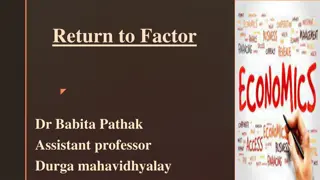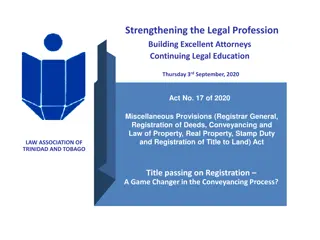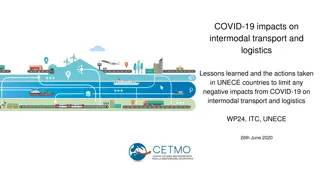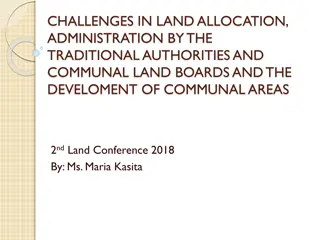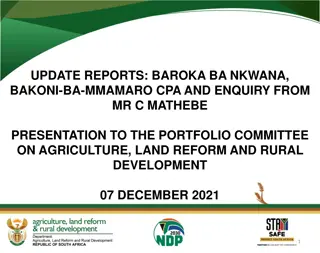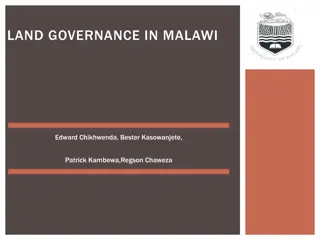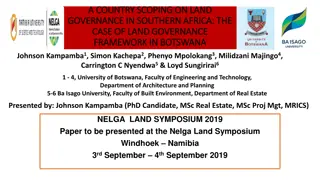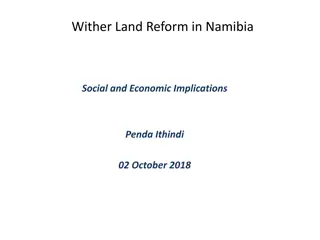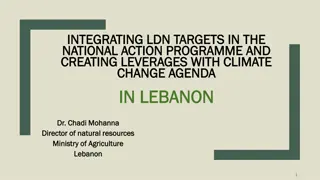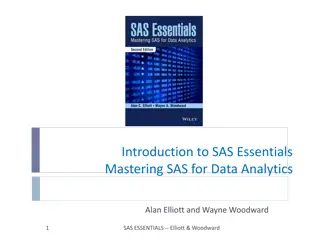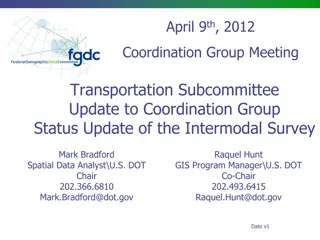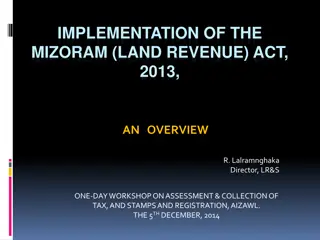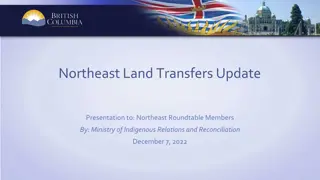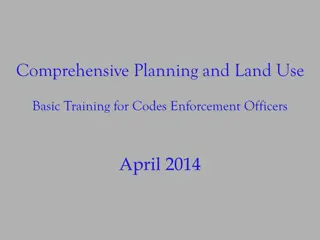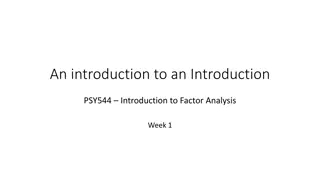
Efficiency of Land Use in Intermodal Transportation Choices
"Explore how land use efficiency impacts intermodal transportation decisions. Learn about different modes of transportation, including road, rail, and pipelines, and their cost implications. Discover the role of analytical tools in studying land use impact on transportation modes."
Uploaded on | 1 Views
Download Presentation

Please find below an Image/Link to download the presentation.
The content on the website is provided AS IS for your information and personal use only. It may not be sold, licensed, or shared on other websites without obtaining consent from the author. If you encounter any issues during the download, it is possible that the publisher has removed the file from their server.
You are allowed to download the files provided on this website for personal or commercial use, subject to the condition that they are used lawfully. All files are the property of their respective owners.
The content on the website is provided AS IS for your information and personal use only. It may not be sold, licensed, or shared on other websites without obtaining consent from the author.
E N D
Presentation Transcript
SPCE Sunday, 13 April 2025 LAND USE EFFICIENCY AS A FACTOR FOR INTERMODAL CHOICE 1
SPCE Sunday, 13 April 2025 OUTLINE Modes of Transportation Intermodal transportation Modal Transportation and Cost Land Use Impact on mode and analytical tools to study LUI Railways Land use efficient and Cost benefit mode 2
SPCE Sunday, 13 April 2025 TRANSPORTATION The aim of transport a reliable and safe manner, on time, cost effectively and efficiently to its destination. transport is to physically move people and supplies in Transport modes achieve mobility. modes are the means by which people and freight They fall into one of three basic types, depending on over what surface they travel land (road, rail and pipelines), water (shipping), and Air (Aeroplanes) Each mode is characterized by a set of technical, operational and commercial characteristics 3
SPCE Sunday, 13 April 2025 ROAD TRANSPORT Road infrastructures are large consumers of space with the lowest level of physical constraints lowest level of physical constraints among transportation modes. However, physiographical constraints are significant physiographical constraints are significant in road construction with substantial additional costs to overcome features such as rivers or rugged terrain. Historically road transportation was developed to support non- motorized forms of transportation, but it is motorization that has shaped the most its development. Road transportation has an average operational flexibility average operational flexibility as vehicles can serve several purposes but are rarely able to move outside roads. Road transport systems have high maintenance costs high maintenance costs, both for the vehicles and infrastructures. 4
SPCE Sunday, 13 April 2025 RAIL TRANSPORT Railways are composed of a traced path vehicles are bound to move. In light of more recent technological developments, rail transportation also include monorails and maglev They have an average level of physical constrains average level of physical constrains linked to the types of locomotives and a low gradient is required, particularly for freight. Heavy industries Heavy industries are traditionally linked with rail transport systems. Rail is the land transportation mode offering the highest carrying capacity carrying capacity with a 23,000 tons fully loaded coal unit train being the heaviest load ever carried. Gauges Gauges, , however, vary around the world, often challenging the integration of rail systems. traced path on which wheeled monorails and maglev. highest 5
SPCE Sunday, 13 April 2025 PIPELINES Pipeline routes are practically unlimited land or under water. The longest gas pipeline longest gas pipeline links Alberta to Sarnia (Canada), which is 2,911 km in length. The longest oil pipeline Transiberian, extending over 9,344 km from the Russian arctic oilfields in eastern Siberia to Western Europe. Physical constraints are low Physical constraints are low pertaining to landscape. Pipeline construction costs construction costs vary according to the diameter and increase proportionally with the distance and with the viscosity of fluids (from gas - low viscosity, to oil- high viscosity). Pipeline terminals terminals are very important since they correspond to refineries and harbors. unlimited as they can be laid on longest oil pipeline is the 6
SPCE Sunday, 13 April 2025 MARITIME TRANSPORTATION Because of the physical properties of water conferring buoyancy and limited friction, maritime transportation is the most effective mode most effective mode to move large quantities of cargo over long distances. Main maritime routes maritime routes are composed of oceans, coasts, seas, lakes, rivers and channels. Maritime transportation has high terminal costs high terminal costs, since port infrastructures are among the most expensive to build, maintain and improve. More than any other mode, maritime transportation is linked to heavy industries heavy industries, such as steel and petrochemical facilities adjacent to port sites. linked to 7
SPCE Sunday, 13 April 2025 AIR TRANSPORTATION Air routes are practically unlimited practically unlimited, but they are denser over the North Atlantic, inside North America and Europe and over the North Pacific. Air transport constraints are multidimensional constraints are multidimensional and include the site (a commercial plane needs about 3,300 meters of runway for landing and take off), the climate, fog and aerial currents. Air activities are linked to the tertiary and quaternary sectors tertiary and quaternary sectors, notably finance and tourism, which lean on the long distance mobility of people. More recently, air transportation has been accommodating growing quantities of high value freight high value freight and is playing a growing role in global logistics. 8
SPCE Sunday, 13 April 2025 TELECOMMUNICATIONS Cover a grey area in terms of if they can be considered as a transport mode transport mode since unlike true transportation, telecommunications often does not have a physicality. Yet, they are structured as networks with a practically unlimited capacity capacity with very low constraints, which may include the physiography and oceanic masses that may impair the setting of cables. They provide for the instantaneous movement instantaneous movement of information. High network costs and low distribution costs characterize many telecommunication networks, which are linked to the tertiary and quaternary sectors tertiary and quaternary sectors (stock markets, business to business information networks, etc.). Telecommunications can provide a substitution for personal movements movements in some economic sectors. can be considered as a unlimited a substitution for personal 9
INTERMODAL TRANSPORTATION Intermodalism Containerization Modal Choice and Intermodal Transport Costs
INTERMODALISM Integrated transport systems Use of at least two different modes to destination through an intermodal transport chain. Techniques for transferring freight transferring freight from one mode to another have facilitated intermodal transfers. The container container has been the major development: Becoming a privileged mode of shipping for rail and maritime transportation. different modes in a trip from origin
INTERMODAL TRANSPORT CHAIN Interchange Connection Composition Decomposition Local / Regional Distribution National / International Distribution Transport Terminal
MULTIMODAL AND INTERMODAL TRANSPORTATION Multimodal Point-to-Point Network Intermodal Integrated Network C C A A B B Transshipment Rail Road D D Transshipment F F E E
CONTAINERIZATION Container Load unit that can be used by several transport modes. Usable by maritime, railway and road modes. Foremost expression on intermodal transportation. Rectangular shape that can easily be handled. Reference size is the Twenty-foot Equivalent Unit (TEU). The most common container is the 40 footer (12 meters)
CONTAINERIZATION Advantages of containers Standard transport product: Can be manipulated anywhere in the world (ISO standard). All segments of the industry have access to the standard Specialized ships, trucks and wagons. Flexibility of usage: Transport a wide variety of goods ranging. Raw materials, manufactured goods, cars to frozen products. Liquids (oil and chemical products), Perishable food products ( reefers ; 50% of all refrigerated cargo). Management: Unique identification number and a size type code. Transport management not in terms of loads, but in terms of unit.
CONTAINERIZATION Costs: Low transport costs, Speed: Transshipment operations are minimal and rapid. Containerships are on average 35% faster than regular shipping Warehousing: Its own warehouse. Simpler and less expensive packaging. Stacking capacity on ships, trains and on the ground. Security: Contents of the container is unknown to shippers. Can only be opened at the origin, at customs and at the destination. Spoilage and losses (theft), are therefore reduced.
40-FOOT CONTAINERS DOUBLE STACKED ON A RAIL CAR
CONTAINERIZATION Disadvantages Consumption of space. Infrastructure costs. Container handling infrastructures, such as giant cranes, warehousing facilities and inland road and rail access, represent important investments for port authorities and load centers. Stacking. Management logistics. Requires management and tracking of every container. Empty travel. Illicit trade. Common instrument used in the illicit trade of drug and weapons, as well as for illegal immigration. Worries about the usage of containers for terrorism.
MODAL CHOICE AND INTERMODAL TRANSPORT COSTS Modal choice Relationship between transport costs, distance and modal choice: Road transport is usually used for short distances. Railway transport for average distances (from 500 to 750 km). Maritime transport for long distances (above 750 km). Intermodalism: The opportunity to combine modes. Find a less costly alternative than an unimodal solution. Efficiency of contemporary transport systems: Capacity to route freight. Capacity to transship it.
CONNECT BETWEEN MODES OF TRANSPORT AND DEVELOPMENT SPCE Sunday, 13 April 2025 People and freight are forced to use the only available modes that may not be the most effective to support the mobility needs of passengers or freight. For these reasons, transport provision is seen as a major factor in economic development. Areas with limited modal choices tend to be among the least developed. The developed world, on the other hand possesses a wide range of modes that can provide services to meet the needs of society and the economy. 26
WHY LAND USE IMPACT NEED TO BE CONSIDERED ? SPCE Sunday, 13 April 2025 Accessibility Accessibility is the key to understanding the link between transportation and land use. When a transportation project or policy makes it easier to access certain locations, these places can become attractive to more or different types of development. However, improving accessibility does not guarantee that land use changes will follow. The type, amount and timing of land use changes will also depend upon the state of regional economy, the current levels of accessibility, the types of development permitted by land use regulations, the availability of services such as sewer and water, the desirability of the area for development and other factors. 27
WHY LAND USE IMPACT NEED TO BE CONSIDERED ? SPCE Sunday, 13 April 2025 We do know that the type and scope of transportation project or policy change can affect the range of potential outcomes. Larger scale transportation projects like adding capacity to freeways are more likely to produce measurable land use changes than small scale projects like changing signalization on arterials. There has been growing expectation in the society expectation in the society that transportation system services and improvements should contribute to the achievement of local, regional and statewide growth and land used plans and objectives. As a result, transportation planning at both statewide and metropolitan planning organizations (MPOs) levels requires that the impacts of investment decisions on land used patterns be impacts of investment decisions on land used patterns be considered considered. 28
WHY LAND USE IMPACT NEED TO BE CONSIDERED ? SPCE Sunday, 13 April 2025 From a transportation management perspective the effectiveness of capacity improvement, travel demand management initiatives, the use of alternative modes and mobility enhancing investment strategies depend, in part, on land use development patterns land use development patterns. strategies depend, in part, on Thus, there is a need to provide land use impact information and analysis tools and analysis tools to enable transportation decision makers to fully consider land used impacts in their plans and programs. Some of basic types of analytical procedures or tools currently available and in use are :- land use impact information 29
ANALYTICAL TOOLS TO STUDY LAND USE IMPACT SPCE Sunday, 13 April 2025 Use of comprehensive plans and other land use regulations. Use of comprehensive plans and other land use regulations. It is important to understand the land used regulations as applicable, political factors, and economic status of the region. Qualitative methods that tap expert knowledge Qualitative methods that tap expert knowledge. MPOs and DOTs use variety of qualitative methods to understand the complexity of urban development. Panels of experts, interviews, surveys and case studies are qualitative techniques that rely on the knowledge and skill of one or more experts to determine where growth is likely to occur. However, qualitative methods are not substitutes for data collection. 30
ANALYTICAL TOOLS TO STUDY LAND USE IMPACT SPCE Sunday, 13 April 2025 Allocation rules for assigning population and jobs to zones. Allocation rules for assigning population and jobs to zones. Allocation rules use simple trends extrapolations (i.e. fast growing areas will continue to grow rapidly or simple measures of accessibility and other attractiveness factors to allocate expected growth to different zones). Decision rules. Decision rules. Many land use forecasting or impact assessments requires some simple decision rules that quantify certain relationships between transportation and land use. These rules are based on empirical evidence from the region or from other locations with similar projects. 31
ANALYTICAL TOOLS TO STUDY LAND USE IMPACT SPCE Sunday, 13 April 2025 Statistical methods. Statistical methods. Multiple linier regression and discrete choice models are two statistical methods for evaluating the relative roles of multiple factors in shaping land used patterns. Because they consider the effects of multiple variables, they can represent more of the complexity of urban systems than simple allocation or decision rules provided the appropriate variables are included in the analysis. Geographic information system. Geographic information system. GIS system is becoming increasingly popular to analyze manage and map geographic relationships. It has become simpler as new PC based systems have developed. 32
ANALYTICAL TOOLS TO STUDY LAND USE IMPACT SPCE Sunday, 13 April 2025 Regional economic models. Regional economic models. Regional economic models are useful for estimating regional population and employment growth that are needed as an input to other forecasting processes. Numbers of models are commercially available and others have been developed for particular regions by MPOs, DOTs and other state agencies. 33
RAILWAYS - LAND USE EFFICIENT AND COST BENEFIT MODE SPCE Sunday, 13 April 2025 Railways are an efficient transport and goods and transporting them over a fixed route using one prime mover and multiple carriages and freight wagons. efficient transport mode concentrating people Rail transport is generally green mode more fuel efficient than road transport to the extent of average 63 percent. Next to water transport, rail transport is the most energy efficient mode. green mode of transport. Railway is Railways use a unique technology unique technology that has very low friction based on steel wheels and steel rails. 34
RAILWAYS - LAND USE EFFICIENT AND COST BENEFIT MODE SPCE Sunday, 13 April 2025 Railways generally have much smaller land requirement for right right- -of of- -way way than highway transport. land requirement for Although railway freight lines generally require lower gradients and more gentle curves than road transport, which increases rail circuitry in mountainous terrain, railways usually have a much smaller land use foot much smaller land use foot- -print print than road transport and often require substantially less investment per kilometer than water or road transport with equivalent capacity. Rail right-of-way is also environment friendly is porous and railway lines have much smaller impact on water drainage and nearby waterways than road transport. environment friendly in other ways it 35
RAILWAYS - LAND USE EFFICIENT AND COST BENEFIT MODE SPCE Sunday, 13 April 2025 Inefficiently managed railways, and railways with light usage may not be so environmentally (or economically) efficient. Railways with very light axle very light axle- -loads can be less energy efficient loads can be less energy efficient than road transport for freight because rail freight wagons typically weight much more than highway vehicles. High High- -speed trains with low load factors can be less efficient speed trains with low load factors can be less efficient than even automobiles or airplanes. Environmental and efficiency benefits depend upon an efficiently designed and managed railway system. Containerization Containerization has made railways even more relatively cost efficient mode. 36
RAILWAYS - LAND USE EFFICIENT AND COST BENEFIT MODE SPCE Sunday, 13 April 2025 Beyond energy efficiency, transport by rail can also achieve significant economies of scale significant economies of scale that a single rail train (locomotives + wagons or carriages) that can move many tons of freight or passengers at once making it operationally highly efficient when there is enough volume to use available capacity. achieve Railways are ideal to transport high volumes of bulk commodities or passengers commodities or passengers. bulk Rail transport costs costs for bulk materials are generally quite low quite low. 37
RAILWAYS - LAND USE EFFICIENT AND COST BENEFIT MODE SPCE Sunday, 13 April 2025 Price variations arise from Price variations arise from government policy choices, management effectiveness, design characteristics, and differences in volume, cost structures, competitive environments, commodity mixes, geography, haul lengths, among many other factors. Railways are much economical to build construction of any mode of transport is space on which it operates. economical to build. Costliest component of In case of railway required way leave is highly limited and can pass through areas where land is relatively less costly. pass through areas where land is relatively less costly. 38
SPCE Sunday, 13 April 2025 ROAD VS RAIL INTERMODAL PRICES 39
DISTANCE, MODAL CHOICE AND TRANSPORT COSTS C1 C2 Transport costs per unit Road C3 Rail Maritime D1 D2 Distance
SPCE Sunday, 13 April 2025 thanks 41



